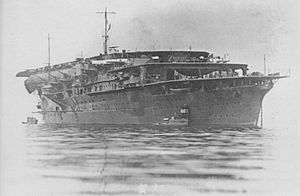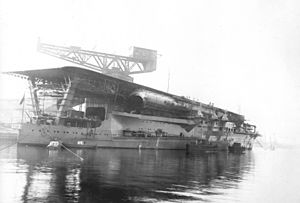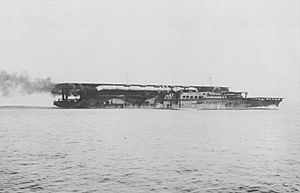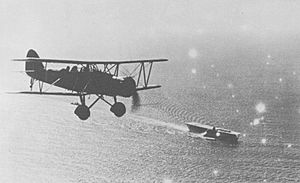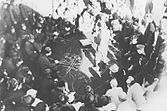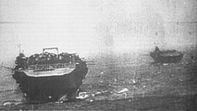Japanese aircraft carrier Kaga facts for kids
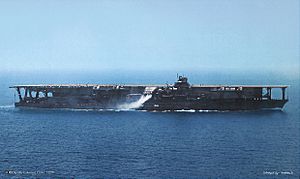
Kaga after her modernization, with her distinctive downward-facing funnel
|
|
Quick facts for kids Class overview |
|
|---|---|
| Operators: | |
| Preceded by: | Akagi |
| Succeeded by: | Ryūjō |
| Built: | 1920–1928 |
| In service: | 1928–1942 |
| In commission: | 1928–1942 |
| Completed: | 1 |
| Lost: | 1 |
| History | |
| Name | Kaga |
| Namesake | Kaga Province |
| Builder | Kawasaki and Yokosuka Naval Arsenal |
| Cost | ¥53 million ($36.45 million) |
| Laid down | 19 July 1920 |
| Launched | 17 November 1921 |
| Completed | 31 March 1928 |
| Commissioned | 30 November 1929 |
| Reclassified | 21 November 1923 as an aircraft carrier |
| Refit | 20 October 1933 – 25 June 1935 |
| Stricken | 10 August 1942 |
| Fate | Sunk by dive bombers from the USS Enterprise (CV-6) during the Battle of Midway, 4 June 1942 |
| General characteristics (after 1935 modernization) | |
| Type | Aircraft carrier |
| Displacement | 38,200 long tons (38,813 t) (standard) |
| Length | 247.65 m (812 ft 6 in) |
| Beam | 32.5 m (106 ft 8 in) |
| Draft | 9.48 m (31 ft 1 in) |
| Installed power |
|
| Propulsion | 4 shafts; 4 geared steam turbines |
| Speed | 28 knots (52 km/h; 32 mph) |
| Endurance | 10,000 nmi (19,000 km; 12,000 mi) at 15 knots (28 km/h; 17 mph) |
| Complement | 1,708 (after reconstruction) |
| Armament |
|
| Armor |
|
| Aircraft carried |
|
The Kaga (加賀) was a famous aircraft carrier built for the Imperial Japanese Navy (IJN). It was named after the old Kaga Province in Japan. Kaga was originally planned to be a battleship, but due to the Washington Naval Treaty, it was changed into an aircraft carrier. This happened after another ship, the battlecruiser Amagi, was badly damaged in the 1923 Great Kantō earthquake. Kaga was rebuilt between 1933 and 1935. This upgrade made her faster, improved her smoke stacks, and made her flight decks ready for newer, heavier planes.
Kaga played a big part in how the Japanese Navy developed its carrier strategy. This strategy involved grouping carriers together to make their air power stronger. This was a new idea at the time. Using this strategy helped Japan achieve its early goals in the first six months of the Pacific War.
Kaga's planes first helped Japanese soldiers in China during the Shanghai Incident in 1932. She also took part in the Second Sino-Japanese War in the late 1930s. With other carriers, she was part of the Pearl Harbor raid in December 1941. She also helped with the invasion of Rabaul in January 1942. The next month, her planes joined an airstrike on Darwin, Australia. This helped Japan take over the Dutch East Indies. Kaga missed the Indian Ocean raid in April because she needed repairs after hitting a reef in February.
After repairs, Kaga rejoined the 1st Air Fleet for the Battle of Midway in June 1942. After attacking American forces on Midway Atoll, Kaga and three other Japanese carriers were attacked by American planes. These planes came from Midway and from the carriers Enterprise, Hornet, and Yorktown. Dive bombers from Enterprise badly damaged Kaga. When it was clear she couldn't be saved, Japanese destroyers sank her on purpose. This was to stop her from falling into enemy hands. Losing Kaga and three other Japanese carriers at Midway was a huge blow for Japan. It played a big part in Japan's final defeat. In 1999, parts of Kaga, including a large piece of her hull, were found on the ocean floor. In 2019, the RV Petrel found her main wreck.
Contents
Building the Kaga
Kaga was first planned as a battleship. She was launched on November 17, 1921, at the Kawasaki Heavy Industries shipyard in Kobe. However, on February 5, 1922, the plans for Kaga and another ship were canceled. This was because of the Washington Naval Treaty, which limited the size of navies.
The Treaty allowed two battleship or battlecruiser hulls to be turned into aircraft carriers. The incomplete battlecruisers Amagi and Akagi were first chosen. But the 1923 Great Kantō earthquake in 1923 damaged Amagi's hull too much to fix easily. So, Kaga was chosen to replace her. The official decision to change Kaga into an aircraft carrier was made on December 13, 1923. But work didn't start until 1925 because new plans were needed. Also, the Yokosuka Naval Arsenal had to be repaired after the earthquake. Kaga was officially ready on March 31, 1928, but this was just the start of her tests. She joined the Combined Fleet on November 30, 1929. She was the third Japanese carrier to be ready for service, after Hōshō (1922) and Akagi (1927).
When finished, Kaga was 238.5 meters (782 ft 6 in) long. She was 31.67 meters (103 ft 11 in) wide. Her draft (how deep she sat in the water) was 7.92 meters (26 ft). She weighed 26,900 long tons (27,300 t) when empty. Her crew had 1,340 people.
Flight Decks and Aircraft
Kaga, like Akagi, was built with three flight decks on top of each other. No other carriers were designed this way. This was done to allow planes to take off and land at the same time. Kaga's main flight deck was 171.2 meters (561 ft 8 in) long. Her middle flight deck was only about 15 meters (49 ft 3 in) long. Her lowest flight deck was about 55 meters (180 ft 5 in) long. The middle flight deck wasn't very useful because it was too short for most planes. As planes got bigger and heavier in the 1930s, even the lowest flight deck became too short for take-offs. So, it was covered over when the ship was updated in the mid-1930s. Kaga did not have a command tower (called an island) until her big update.
The ship had two main hangar decks and a smaller third hangar. Together, they could hold 60 aircraft. The hangars opened onto the middle and lower flight decks. This allowed planes to take off directly from the hangars. No catapults were used. Her front aircraft elevator was on the right side and measured 10.67 by 15.85 meters (35 by 52 ft). Her back elevator was in the middle and measured 12.8 by 9.15 meters (42 by 30 ft). Kaga used a French system for landing planes. When first built, Kaga carried 28 Mitsubishi B1M3 torpedo bombers, 16 Nakajima A1N fighters, and 16 Mitsubishi 2MR reconnaissance planes.
Weapons and Protection
Kaga had ten 8-inch (20 cm (7.9 in)) guns. Two were in a turret on each side of the middle flight deck. Six more were in protected rooms (called casemates) at the back. These guns could fire heavy shells. They were meant to protect the carrier if enemy cruisers attacked. But carriers have large, weak flight decks and hangars. This made them easy targets in a gunfight. At this time, naval leaders were still figuring out how carriers should be used. They didn't yet realize that carriers shouldn't fight gun battles.
For anti-aircraft defense, she had six twin 4.7-inch (12-centimeter (4.7 in)) guns. These were placed on platforms (called sponsons) below the funnels. This meant they couldn't fire across the flight deck. These guns fired shells to hit enemy planes. Kaga's armor belt (protection around the waterline) was made thinner during her rebuild, from 280 to 152 mm (11 to 6 in). Her deck armor was also made thinner, from 102 to 38 mm (4 to 1 in).
Engines and Speed
When Kaga was designed, engineers weren't sure how to handle the exhaust gases from the engines on an aircraft carrier. Kaga had long horizontal ducts that released the gases at the back of the flight deck. But this didn't work well. The hot gases rose and made it hard for planes to land. Also, the heat made the crew's living areas near the funnels very hot.
Kaga had four steam turbines with 91,000 shaft horsepower (68,000 kW) of power. This allowed her to reach a speed of 27.5 knots (50.9 km/h; 31.6 mph) during tests. She had twelve boilers. Eight of them used oil, and four used a mix of oil and coal. She could carry 8,000 long tons (8,128 t) of fuel oil and 1,700 long tons (1,727 t) of coal. This gave her a range of 8,000 nautical miles (15,000 km; 9,200 mi) at 14 knots (26 km/h; 16 mph).
Early Service and Carrier Strategy
On December 1, 1931, Kaga became the main ship of the First Carrier Division. On January 29, 1932, Kaga and another carrier, Hōshō, went to Chinese waters. They were there to support Japanese troops during the Shanghai Incident. Kaga's planes were the main bombers used in the fighting over Shanghai.
Kagas planes flew missions to support Japanese ground forces throughout February 1932. On February 22, three of Kagas fighters shot down an American plane. This was the first air-to-air victory for the Japanese Navy. Kaga returned to Japan after the fighting stopped on March 3. She then continued training with the rest of the fleet.
At this time, the Japanese Navy was still developing its carrier strategy. At first, carriers like Kaga were meant to support battleships by attacking enemy battleships with bombs and torpedoes. Later, around 1932–1933, attacking enemy carriers became just as important. The goal was to gain air superiority (control of the sky) early in a battle. This strategy required Japanese carrier planes to strike first with a large, combined attack. So, in training, carriers began to work together. This new strategy needed faster carriers and planes. It also needed larger planes with a longer range. This meant carriers needed longer flight decks for the new, heavier aircraft.
Kaga was soon seen as not as good as Akagi because she was slower. She also had a smaller flight deck and a problematic funnel system. Because of these issues, Kaga was chosen for a major upgrade before Akagi. Kaga was taken out of active service on October 20, 1933, to begin her second big reconstruction.
Reconstruction
During her second reconstruction, Kaga's two lower flight decks were turned into hangars. The main flight deck was also made longer, reaching the front of the ship. This made the flight deck 248.55 meters (815 ft 5 in) long. It also increased her aircraft capacity to 90 planes (72 ready to fly and 18 in storage). A third elevator was added at the front to serve the longer hangars. Bomb and torpedo elevators were changed to deliver weapons directly to the flight deck. Her landing gear was replaced with a new Japanese system. A small command tower (island) was also added on the right side.
Her engines were completely replaced. Kaga was given eight improved oil-burning boilers. New turbines were installed, which increased her power from 91,000 to 127,400 shp (67,859 to 95,002 kW). The ship's hull was lengthened by 10.3 meters (33 ft 10 in) at the back to reduce drag. She also got more armor on her sides to make her wider and more stable. This increased her weight significantly, from 26,900 to 38,200 long tons (27,332 to 38,813 t). The extra power and weight balanced each other out, and her speed increased slightly to 28.34 knots (52.49 km/h; 32.61 mph). Her fuel storage was increased to 7,500 long tons (7,620 t) of fuel oil. This allowed her to travel 10,000 nmi (19,000 km; 12,000 mi) at 16 knots (30 km/h; 18 mph). The long funnel ducts were replaced by a single downturned funnel on the right side. This new funnel was like the one on Akagi. The space saved by removing the old ducts was turned into living quarters for the larger air group. The carrier's crew grew to 1,708 people.
The two twin gun turrets on the middle flight deck were removed. Four new 8-inch (20 centimetres (7.9 in)) guns were added in protected rooms at the front. Her 4.7-inch (12-centimeter (4.7 in)) anti-aircraft guns were replaced by eight 5-inch (12.7-centimeter (5.0 in)) guns in twin mounts. These guns fired heavier shells and could shoot faster. Their platforms were raised to allow them to fire across the deck. Eleven twin 25 mm (25 mm (1 in)) anti-aircraft gun mounts were also added. These fired smaller shells very quickly.
Several major weaknesses in Kagas design were not fixed. Kagas aviation fuel tanks were built directly into the ship's structure. This meant that any shock to the ship, like from a bomb, could cause cracks or leaks in the tanks. Also, the new hangar decks were fully enclosed. This made it hard to put out fires, especially because fuel vapors could build up inside. To make things worse, Japanese carrier rules said that planes should be refueled and armed in the hangars, not on the flight deck. The carrier's hangars and flight deck also had little armor protection. Plus, there was no backup system for putting out fires. These weaknesses would later be key reasons for the ship's loss.
Sino-Japanese War
Kaga returned to service in 1935. She was assigned to the Second Carrier Division. The carrier received new planes, including 16 Nakajima A2N fighters, 16 Aichi D1A dive bombers, and 28 Mitsubishi B2M torpedo bombers.
When fighting started again with China in July 1937, Kaga was in Japan. Her fighter squadron finished training and then helped escort ships carrying army troops to China. On August 15, she joined the 3rd Fleet in the East China Sea. She began supporting Japanese military actions along the central China coast, around Shanghai and further inland.
Kagas planes fought their first battle on August 15, 1937. Dive-bombers from Kaga met Chinese Air Force attack-bombers. Two of Kagas planes were shot down. On August 16, six of Kagas fighters shot down three Chinese planes without any losses. Between August 17 and September 7, Kagas fighters fought Chinese planes several more times. Kagas pilots claimed to have shot down 10 Chinese planes without losing any of their own. On August 17, twelve of the carrier's bombers attacked Hangchow without fighter protection. Eleven of them were shot down by Chinese fighters. On September 7, three of Kagas fighters escorted six bombers. They were attacked by Chinese planes, and two bombers were quickly shot down.
On September 26, the carrier went to Sasebo for supplies. There, she received new planes, including 32 Yokosuka B4Y torpedo bombers, 16 Aichi D1A2 dive bombers, and 16 more fighters.
Kaga returned to the front in early October 1937. Except for two short trips to Sasebo, she stayed off China until December 1938. Using Taiwan as her base, the carrier traveled 29,048 nautical miles (53,797 km; 33,428 mi) supporting military actions. Kagas bombers attacked enemy railroad bridges, airfields, and vehicles. The carrier's fighter pilots claimed to have destroyed at least 17 Chinese planes in air combat, while losing five of their own. On December 12, 1937, Kagas planes were involved in the Panay incident.
On November 11, 1937, three Chinese Air Force planes attacked Kaga near Shanghai. Their bombs missed. Kaga's fighters chased them and shot down two. On April 13, 1938, Kaga launched 18 dive bombers and six fighters to attack Canton. They were met by two squadrons of Chinese fighters.
Kaga entered the shipyard on December 15, 1938. Her landing gear was replaced, and her bridge was updated. The flight deck and hangar areas were made larger, increasing the carrier's plane capacity. The ship was fully overhauled from November 15, 1939, to November 15, 1940, before returning to active service. By then, a new generation of planes was available. Kaga received 12 fighters, 24 dive bombers, and 36 torpedo bombers. Another 18 planes were carried as spares.
The Japanese carriers' experiences in China helped them further develop their carrier strategy. One lesson was the importance of grouping many naval planes together to attack targets on land. So, in April 1941, the Japanese Navy formed the First Air Fleet. This fleet combined all its carriers under one command. On April 10, 1941, Kaga was assigned to the First Carrier Division with Akagi. This new carrier fleet also included the Second and Fifth carrier divisions. The Japanese Navy focused on air attacks that combined the air groups from different carrier divisions. This strategy of combined, large-scale carrier air attacks was the most advanced in the world at the time. However, the Japanese Navy was worried that putting all its carriers together would make them easy targets for a massive enemy attack. So, they decided that the carriers would operate closely within their divisions, but the divisions themselves would be spread out.
Even though grouping so many carriers was a new and powerful idea, the First Air Fleet had some weaknesses in defense. Japanese carrier anti-aircraft guns and their control systems were not very effective. The fleet's air patrol had too few fighter planes. It also lacked a good early warning system, like radar. Poor radio communication with the fighter planes made it hard to control them. The warships escorting the carriers were spread out as scouts, not as close anti-aircraft protectors. This was because they lacked training and proper guns. These weaknesses would later lead to the loss of Kaga and other carriers.
World War II
Pearl Harbor Attack
In November 1941, the Japanese Navy's Combined Fleet prepared to start a war with the United States. They planned a surprise attack on the United States Navy's Pacific Fleet base at Pearl Harbor, Hawaii. On November 17, Kaga, led by Captain Jisaku Okada, loaded 100 torpedoes. These torpedoes were specially made for the shallow waters of Pearl Harbor. On November 19, Kaga and the rest of the fleet's main strike force, called the Kido Butai, gathered at Hitokappu Bay. This force included six carriers from the First, Second, and Fifth Carrier Divisions. The fleet left on November 26, sailing across the Pacific to avoid shipping lanes.
For the Pearl Harbor attack, Kaga carried 18 Mitsubishi A6M Zero fighters, 27 Nakajima B5N torpedo bombers, and 27 Aichi D3A dive bombers. She also had three crated planes of each type as spares. On the morning of December 7, 1941, Kagas planes took part in both attacks launched against Oahu. In the first attack, 26 of Kagas B5N bombers attacked American ships with bombs and torpedoes. They were protected by nine Zeros. In the second attack, 26 of Kagas D3A dive bombers targeted the airfield at Ford Island. Nine Zeros provided protection and attacked planes on the ground. In total, five B5Ns, four Zeros, and six D3As from Kaga were lost, along with their crews. Kagas bomber crews claimed hits on several battleships. Her fighter pilots claimed to have shot down one US plane and destroyed 20 on the ground. After the attack, Kaga and the other carriers returned to Japan.
Pacific Conquest
In January 1942, Kaga and the other carriers supported the invasion of Rabaul in the Bismarck Islands. Kaga sent 27 bombers and 9 Zeros for the first airstrike on Rabaul on January 20, 1942. One bomber was shot down. The next day, the First Carrier Division attacked Allied positions at nearby Kavieng. Kaga sent nine Zeros and sixteen dive bombers. On the 22nd, Kaga's planes attacked Rabaul again. Kaga returned to Truk on January 25. Rabaul and Kavieng were successfully taken by Japanese forces by February.
On February 9, Kaga hit a reef at Palau after trying to attack American carrier forces. The damage slowed the carrier to 18 knots. After temporary repairs, she continued to the Timor Sea. On February 19, 1942, she, along with other carriers, launched air strikes against Darwin, Australia. Kaga sent 27 bombers, 18 dive bombers, and 9 Zeros. The attack surprised the defenders. Eight ships were sunk, and fourteen more were damaged. Only one of Kaga's bombers was lost. In March 1942, Kaga helped cover the invasion of Java. Kaga sent 27 bombers and nine Zeros for the March 5, 1942, airstrike on Tjilatjap. The planes bombed merchant ships in the harbor, sinking eight of them. Most Allied forces in the Dutch East Indies surrendered to the Japanese later in March. Kaga could not join the Indian Ocean raid in April because of the damage she had received. Instead, she sailed to Sasebo on March 15 for repairs, which were finished on May 4.
Battle of Midway
Midway Attack
The Japanese commander, Isoroku Yamamoto, was worried by US carrier attacks. He decided to force the US Navy into a big battle to get rid of the American carrier threat. Yamamoto decided to invade and take over Midway Island. He was sure this would make the American carriers come out and fight. The Midway invasion was called Operation MI by the Japanese.
To support Operation MI, Kaga left Japan on May 27, 1942, for her final mission. She was with the carriers Akagi, Hiryū, and Sōryū. These ships made up the First and Second Carrier Divisions. Kaga had 27 Zeros, 20 dive bombers, and 27 torpedo bombers. On June 4, 1942, at dawn, the fleet was 250 nmi (460 km; 290 mi) northwest of Midway Island. Kaga sent 18 dive bombers, protected by nine Zeros, to attack the island. Her torpedo bombers were kept ready in case enemy ships were found. One dive bomber and one Zero were shot down over Midway. Another four dive bombers were damaged. Kaga's Zero pilots claimed to have shot down 12 US planes over Midway Island. Kaga also sent two Zeros for air patrol. Five more Zeros joined her patrol at 07:00. These seven fighters helped defend the Japanese fleet from the first US air attackers from Midway Island at 07:10. The Japanese did not know that the US Navy had figured out their plan. The US had set up an ambush with its three carriers, located northeast of Midway.
At 07:15, Admiral Nagumo ordered the torpedo bombers on Kaga and Akagi to be rearmed with bombs. This was for another attack on Midway. This process was slow because of limited equipment. It usually took about an hour and a half. Around 07:40, Nagumo changed his order when he heard that American carriers had been spotted. At 07:30, Kaga recovered three of her patrol planes.
Sinking of Kaga
Kaga's four remaining patrol fighters were landing when 16 US Marine dive-bombers from Midway attacked Hiryu around 07:55. They missed. Five Zeros were launched at 08:15. Three of them intercepted a dozen US Army bombers trying to bomb the other three carriers. The bombers were not badly damaged, and their attacks missed. Five dive bombers also joined the air patrol around this time. Another three Zeros were launched at 08:30. Kaga began landing her planes returning from Midway around 08:35 and finished by 08:50. One Zero pilot died after crash-landing.
The five Zeros launched at 08:15 were recovered at 09:10. They were replaced by six more Zeros launched at 09:20. These intercepted the first US carrier planes to attack, torpedo-bombers from the US carrier Hornet at 09:22. All 15 were shot down, with only one survivor. Soon after, 14 torpedo-bombers from the US carrier Enterprise were spotted. They tried to attack Kaga, but the Japanese fighters shot down all but four. Kaga dodged the torpedoes.
Soon after the torpedo plane attacks, American carrier dive bombers arrived over the Japanese carriers almost unseen. At 10:22, 25 dive-bombers from Enterprise hit Kaga with one 1000-pound bomb and at least three 500-pound bombs. The first bomb landed near her back elevator and started fires in the living areas. The next bomb hit the front elevator and went into the upper hangar. This caused explosions and fires among the armed planes in the hangar. The third bomb hit the command tower directly, destroying the bridge and killing Captain Okada and most of his staff. The 1000-pound bomb hit the middle of the ship and went through the flight deck into the upper hangar. The explosions broke the ship's fuel lines. They also damaged her fire hoses and the emergency generator for her fire pumps. The carbon dioxide fire suppression system was also knocked out. The fuel pouring onto the hangar deck fed the fires. This caused the bombs and torpedoes in the hangar to explode in a series of huge blasts. These blasts blew out the sides of the hangar. At almost the same time, dive bombers hit and badly damaged Akagi and Sōryū.
Kaga could not control her fires. Her survivors were taken off by the destroyers Hagikaze and Maikaze between 14:00 and 17:00. Around 19:25, she was sunk on purpose by two torpedoes from Hagikaze. She sank stern-first at position 30°23′N 179°17′W / 30.383°N 179.283°W. A rescued crew member described the scene: "My comrade carried me up to the deck so I could see the last moments of our beloved carrier, which was nearby. Even though I was in pain tears started to run down my cheeks, and everyone around me was crying; it was a very sad sight."
The carrier lost 811 crew members. Most were aircraft mechanics and armorers in the hangars, and engineers trapped below by the fires. Twenty-one of the ship's pilots were killed. Kaga's surviving crew members were kept isolated at an airbase in Japan for one to two months. This was to keep the news of the Midway defeat secret from the public. Many survivors were then sent back to fighting units without being allowed to contact their families. Some injured crew were kept in hospitals for almost a year. Kaga had the highest percentage of deaths among the Japanese carriers lost at Midway.
The loss of Kaga and the three other Japanese carriers at Midway (Hiryū was also sunk) was a huge strategic defeat for Japan. It played a big part in Japan's final defeat in the war.
Finding the Wreck
In May 1999, the Nauticos Corporation, with the US Navy, found some wreckage from Kaga. They used the research vessel Melville and a special sonar system. A later search in September 1999 found the wreckage and took photos. The wreckage included a 50-foot (15 m) long piece of a hangar wall, two 25 mm anti-aircraft gun tubs, and part of a landing light system. These pieces were found at a depth of 17,000 feet (5,200 m).
On October 18, 2019, the main wreck of Kaga was found by Rob Kraft and Frank Thompson aboard the RV Petrel. She sits upright at a depth of about 5.4 km (18,000 ft). Most of her upper structure and flight deck are missing. The wreck is surrounded by a large field of debris and has a lot of marine life growing on it. The wreck of Akagi was found by the same team two days later.
Images for kids
-
Kaga (foreground), with Zuikaku (background), heads towards Pearl Harbor sometime between 26 November and 7 December 1941.
See also
 In Spanish: Kaga (1929) para niños
In Spanish: Kaga (1929) para niños


